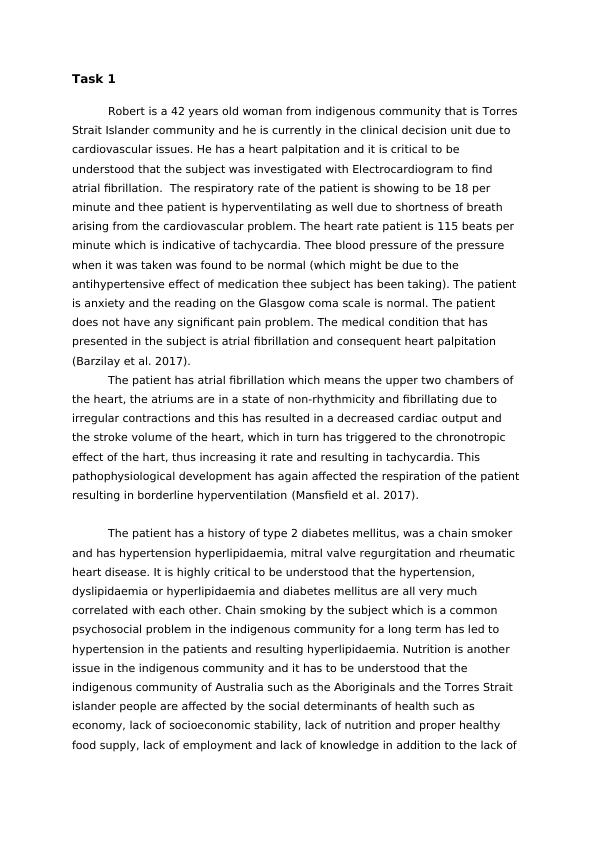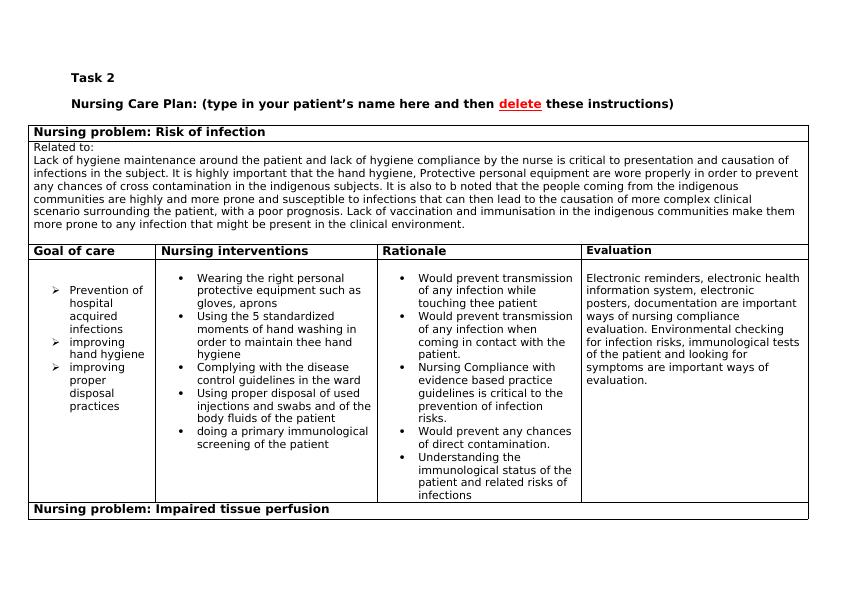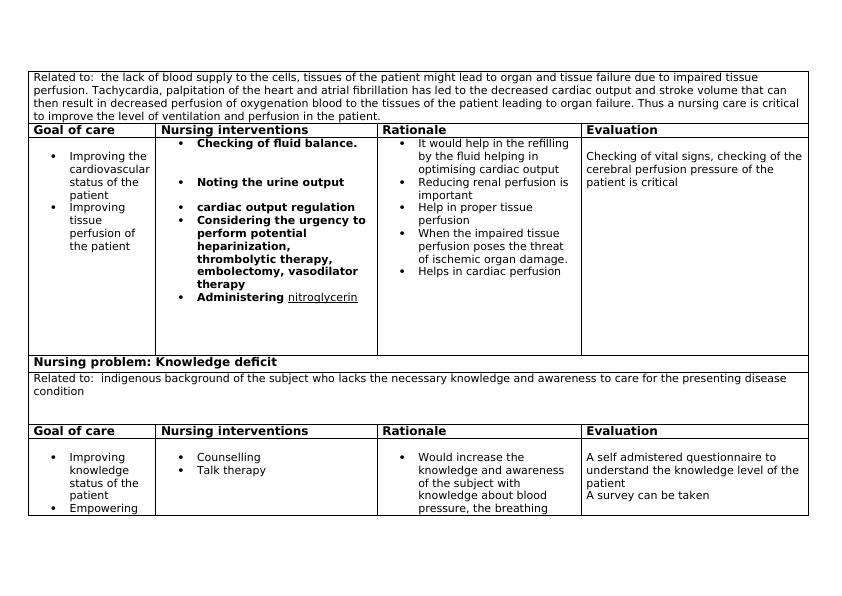Nursing Care Plan | Risk of Infection
Added on 2022-08-13
11 Pages2803 Words24 Views
Task 1
Robert is a 42 years old woman from indigenous community that is Torres
Strait Islander community and he is currently in the clinical decision unit due to
cardiovascular issues. He has a heart palpitation and it is critical to be
understood that the subject was investigated with Electrocardiogram to find
atrial fibrillation. The respiratory rate of the patient is showing to be 18 per
minute and thee patient is hyperventilating as well due to shortness of breath
arising from the cardiovascular problem. The heart rate patient is 115 beats per
minute which is indicative of tachycardia. Thee blood pressure of the pressure
when it was taken was found to be normal (which might be due to the
antihypertensive effect of medication thee subject has been taking). The patient
is anxiety and the reading on the Glasgow coma scale is normal. The patient
does not have any significant pain problem. The medical condition that has
presented in the subject is atrial fibrillation and consequent heart palpitation
(Barzilay et al. 2017).
The patient has atrial fibrillation which means the upper two chambers of
the heart, the atriums are in a state of non-rhythmicity and fibrillating due to
irregular contractions and this has resulted in a decreased cardiac output and
the stroke volume of the heart, which in turn has triggered to the chronotropic
effect of the hart, thus increasing it rate and resulting in tachycardia. This
pathophysiological development has again affected the respiration of the patient
resulting in borderline hyperventilation (Mansfield et al. 2017).
The patient has a history of type 2 diabetes mellitus, was a chain smoker
and has hypertension hyperlipidaemia, mitral valve regurgitation and rheumatic
heart disease. It is highly critical to be understood that the hypertension,
dyslipidaemia or hyperlipidaemia and diabetes mellitus are all very much
correlated with each other. Chain smoking by the subject which is a common
psychosocial problem in the indigenous community for a long term has led to
hypertension in the patients and resulting hyperlipidaemia. Nutrition is another
issue in the indigenous community and it has to be understood that the
indigenous community of Australia such as the Aboriginals and the Torres Strait
islander people are affected by the social determinants of health such as
economy, lack of socioeconomic stability, lack of nutrition and proper healthy
food supply, lack of employment and lack of knowledge in addition to the lack of
Robert is a 42 years old woman from indigenous community that is Torres
Strait Islander community and he is currently in the clinical decision unit due to
cardiovascular issues. He has a heart palpitation and it is critical to be
understood that the subject was investigated with Electrocardiogram to find
atrial fibrillation. The respiratory rate of the patient is showing to be 18 per
minute and thee patient is hyperventilating as well due to shortness of breath
arising from the cardiovascular problem. The heart rate patient is 115 beats per
minute which is indicative of tachycardia. Thee blood pressure of the pressure
when it was taken was found to be normal (which might be due to the
antihypertensive effect of medication thee subject has been taking). The patient
is anxiety and the reading on the Glasgow coma scale is normal. The patient
does not have any significant pain problem. The medical condition that has
presented in the subject is atrial fibrillation and consequent heart palpitation
(Barzilay et al. 2017).
The patient has atrial fibrillation which means the upper two chambers of
the heart, the atriums are in a state of non-rhythmicity and fibrillating due to
irregular contractions and this has resulted in a decreased cardiac output and
the stroke volume of the heart, which in turn has triggered to the chronotropic
effect of the hart, thus increasing it rate and resulting in tachycardia. This
pathophysiological development has again affected the respiration of the patient
resulting in borderline hyperventilation (Mansfield et al. 2017).
The patient has a history of type 2 diabetes mellitus, was a chain smoker
and has hypertension hyperlipidaemia, mitral valve regurgitation and rheumatic
heart disease. It is highly critical to be understood that the hypertension,
dyslipidaemia or hyperlipidaemia and diabetes mellitus are all very much
correlated with each other. Chain smoking by the subject which is a common
psychosocial problem in the indigenous community for a long term has led to
hypertension in the patients and resulting hyperlipidaemia. Nutrition is another
issue in the indigenous community and it has to be understood that the
indigenous community of Australia such as the Aboriginals and the Torres Strait
islander people are affected by the social determinants of health such as
economy, lack of socioeconomic stability, lack of nutrition and proper healthy
food supply, lack of employment and lack of knowledge in addition to the lack of

education in the community settings leads to dyslipidaemia, hypertension and
type 2 diabetes mellitus which has been presented in the subject. Long standing
untreated hypertension in addition to stress and anxiety leads to the more
aggravation in the presentation of the hypertension symptoms and finally it has
led to the presentation of cardiovascular dysfunctional symptoms resulting in
tachycardia, palpitation and with thee clinical presentation of atrial fibrillation
(Komajda et al. 2016). Type 2 diabetes mellitus has a strong association with
hyperlipidaemia in relation to a metabolic dysfunction and it is very important to
understand the comorbid situations has led to presentation of atrial fibrillation
condition in the patient from indigenous community, which is a severe medical
condition (Chang et al. 2016).
type 2 diabetes mellitus which has been presented in the subject. Long standing
untreated hypertension in addition to stress and anxiety leads to the more
aggravation in the presentation of the hypertension symptoms and finally it has
led to the presentation of cardiovascular dysfunctional symptoms resulting in
tachycardia, palpitation and with thee clinical presentation of atrial fibrillation
(Komajda et al. 2016). Type 2 diabetes mellitus has a strong association with
hyperlipidaemia in relation to a metabolic dysfunction and it is very important to
understand the comorbid situations has led to presentation of atrial fibrillation
condition in the patient from indigenous community, which is a severe medical
condition (Chang et al. 2016).

Task 2
Nursing Care Plan: (type in your patient’s name here and then delete these instructions)
Nursing problem: Risk of infection
Related to:
Lack of hygiene maintenance around the patient and lack of hygiene compliance by the nurse is critical to presentation and causation of
infections in the subject. It is highly important that the hand hygiene, Protective personal equipment are wore properly in order to prevent
any chances of cross contamination in the indigenous subjects. It is also to b noted that the people coming from the indigenous
communities are highly and more prone and susceptible to infections that can then lead to the causation of more complex clinical
scenario surrounding the patient, with a poor prognosis. Lack of vaccination and immunisation in the indigenous communities make them
more prone to any infection that might be present in the clinical environment.
Goal of care Nursing interventions Rationale Evaluation
Prevention of
hospital
acquired
infections
improving
hand hygiene
improving
proper
disposal
practices
Wearing the right personal
protective equipment such as
gloves, aprons
Using the 5 standardized
moments of hand washing in
order to maintain thee hand
hygiene
Complying with the disease
control guidelines in the ward
Using proper disposal of used
injections and swabs and of the
body fluids of the patient
doing a primary immunological
screening of the patient
Would prevent transmission
of any infection while
touching thee patient
Would prevent transmission
of any infection when
coming in contact with the
patient.
Nursing Compliance with
evidence based practice
guidelines is critical to the
prevention of infection
risks.
Would prevent any chances
of direct contamination.
Understanding the
immunological status of the
patient and related risks of
infections
Electronic reminders, electronic health
information system, electronic
posters, documentation are important
ways of nursing compliance
evaluation. Environmental checking
for infection risks, immunological tests
of the patient and looking for
symptoms are important ways of
evaluation.
Nursing problem: Impaired tissue perfusion
Nursing Care Plan: (type in your patient’s name here and then delete these instructions)
Nursing problem: Risk of infection
Related to:
Lack of hygiene maintenance around the patient and lack of hygiene compliance by the nurse is critical to presentation and causation of
infections in the subject. It is highly important that the hand hygiene, Protective personal equipment are wore properly in order to prevent
any chances of cross contamination in the indigenous subjects. It is also to b noted that the people coming from the indigenous
communities are highly and more prone and susceptible to infections that can then lead to the causation of more complex clinical
scenario surrounding the patient, with a poor prognosis. Lack of vaccination and immunisation in the indigenous communities make them
more prone to any infection that might be present in the clinical environment.
Goal of care Nursing interventions Rationale Evaluation
Prevention of
hospital
acquired
infections
improving
hand hygiene
improving
proper
disposal
practices
Wearing the right personal
protective equipment such as
gloves, aprons
Using the 5 standardized
moments of hand washing in
order to maintain thee hand
hygiene
Complying with the disease
control guidelines in the ward
Using proper disposal of used
injections and swabs and of the
body fluids of the patient
doing a primary immunological
screening of the patient
Would prevent transmission
of any infection while
touching thee patient
Would prevent transmission
of any infection when
coming in contact with the
patient.
Nursing Compliance with
evidence based practice
guidelines is critical to the
prevention of infection
risks.
Would prevent any chances
of direct contamination.
Understanding the
immunological status of the
patient and related risks of
infections
Electronic reminders, electronic health
information system, electronic
posters, documentation are important
ways of nursing compliance
evaluation. Environmental checking
for infection risks, immunological tests
of the patient and looking for
symptoms are important ways of
evaluation.
Nursing problem: Impaired tissue perfusion

Related to: the lack of blood supply to the cells, tissues of the patient might lead to organ and tissue failure due to impaired tissue
perfusion. Tachycardia, palpitation of the heart and atrial fibrillation has led to the decreased cardiac output and stroke volume that can
then result in decreased perfusion of oxygenation blood to the tissues of the patient leading to organ failure. Thus a nursing care is critical
to improve the level of ventilation and perfusion in the patient.
Goal of care Nursing interventions Rationale Evaluation
Improving the
cardiovascular
status of the
patient
Improving
tissue
perfusion of
the patient
Checking of fluid balance.
Noting the urine output
cardiac output regulation
Considering the urgency to
perform potential
heparinization,
thrombolytic therapy,
embolectomy, vasodilator
therapy
Administering nitroglycerin
It would help in the refilling
by the fluid helping in
optimising cardiac output
Reducing renal perfusion is
important
Help in proper tissue
perfusion
When the impaired tissue
perfusion poses the threat
of ischemic organ damage.
Helps in cardiac perfusion
Checking of vital signs, checking of the
cerebral perfusion pressure of the
patient is critical
Nursing problem: Knowledge deficit
Related to: indigenous background of the subject who lacks the necessary knowledge and awareness to care for the presenting disease
condition
Goal of care Nursing interventions Rationale Evaluation
Improving
knowledge
status of the
patient
Empowering
Counselling
Talk therapy
Would increase the
knowledge and awareness
of the subject with
knowledge about blood
pressure, the breathing
A self admistered questionnaire to
understand the knowledge level of the
patient
A survey can be taken
perfusion. Tachycardia, palpitation of the heart and atrial fibrillation has led to the decreased cardiac output and stroke volume that can
then result in decreased perfusion of oxygenation blood to the tissues of the patient leading to organ failure. Thus a nursing care is critical
to improve the level of ventilation and perfusion in the patient.
Goal of care Nursing interventions Rationale Evaluation
Improving the
cardiovascular
status of the
patient
Improving
tissue
perfusion of
the patient
Checking of fluid balance.
Noting the urine output
cardiac output regulation
Considering the urgency to
perform potential
heparinization,
thrombolytic therapy,
embolectomy, vasodilator
therapy
Administering nitroglycerin
It would help in the refilling
by the fluid helping in
optimising cardiac output
Reducing renal perfusion is
important
Help in proper tissue
perfusion
When the impaired tissue
perfusion poses the threat
of ischemic organ damage.
Helps in cardiac perfusion
Checking of vital signs, checking of the
cerebral perfusion pressure of the
patient is critical
Nursing problem: Knowledge deficit
Related to: indigenous background of the subject who lacks the necessary knowledge and awareness to care for the presenting disease
condition
Goal of care Nursing interventions Rationale Evaluation
Improving
knowledge
status of the
patient
Empowering
Counselling
Talk therapy
Would increase the
knowledge and awareness
of the subject with
knowledge about blood
pressure, the breathing
A self admistered questionnaire to
understand the knowledge level of the
patient
A survey can be taken

End of preview
Want to access all the pages? Upload your documents or become a member.
Related Documents
Nursing Care Plan - Risk of infectionlg...
|10
|2920
|15
Nurse Assignment Australia 2022lg...
|8
|2195
|20
Community Care Assignment in PDFlg...
|12
|3787
|12
